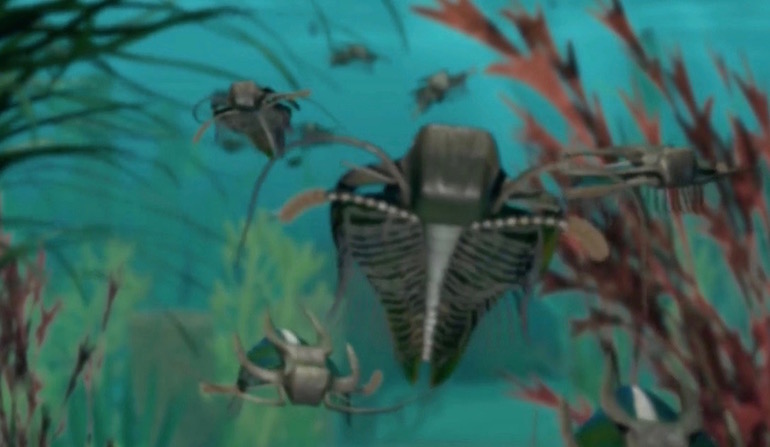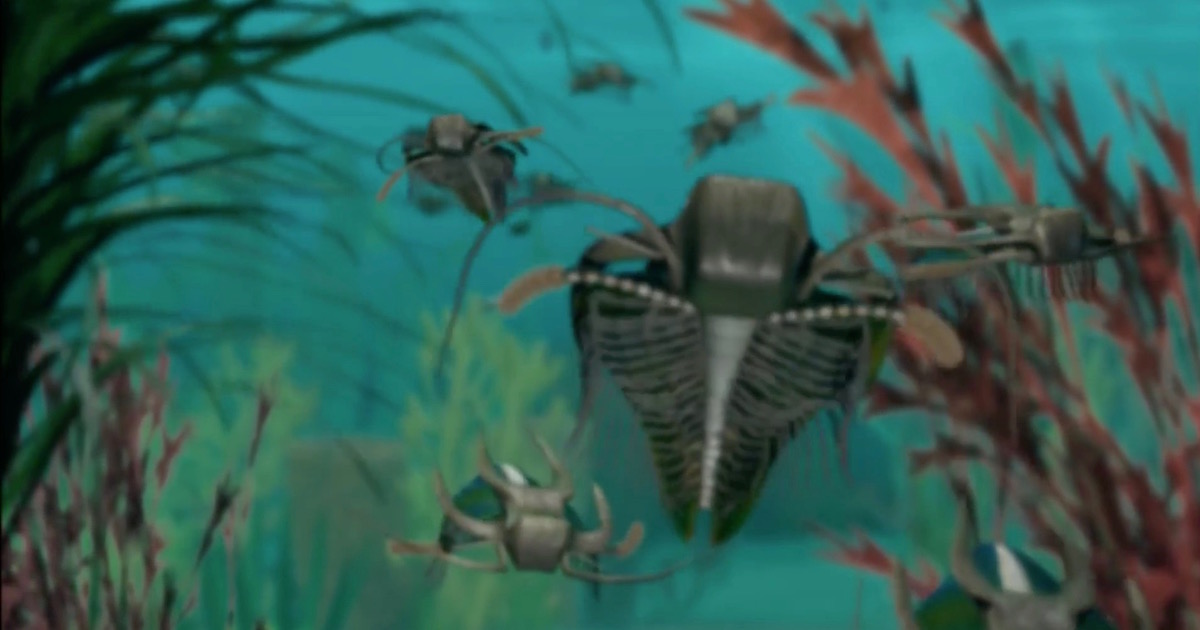 Evolution
Evolution
 Intelligent Design
Intelligent Design
Punctuated Equilibria Is Back, but Still Magical


It’s amazing what you can do with advanced mathematics to explain rabbits coming out of hats without magicians. Make a few assumptions, define some new terms, employ some distribution models, and presto! Adaptive evolution, all done with random processes. You can dazzle the audience with incomprehensible equations, draw stunning graphs, and use them to make outlandish claims. Is this not the case with a new paper by Michael Landis and Joshua Schraiber in the Proceedings of the National Academy of Sciences? The paper, “Pulsed evolution shaped modern vertebrate body sizes,” purports to do just that.
The diversity of forms found among animals on Earth is striking. Despite decades of study, it has been difficult to reconcile the patterns of diversity seen between closely related species with those observed when studying single species on ecological timescales. We propose a set of models, called Lévy processes, to attempt to reconcile rapid evolution between species with the relatively stable distributions of phenotypes seen within species. These models, which have been successfully used to model stock market data, allow for long periods of stasis followed by bursts of rapid change. We find that many vertebrate groups are well fitted by Lévy models compared with models for which traits evolve toward a stationary optimum or evolve in an incremental and wandering manner. [Emphasis added.]
We note that the editor of the paper is Dr. “Your Inner Fish” Neil Shubin of Tiktaalik fame. Landis, from Yale, and Schraiber, from Temple University, are masters of obfuscation in this paper. Astute readers will already know that rabbits do not emerge from hats without intelligent design. Few readers, however, may be able to figure out the trick, if misdirected by the abracadabra called “Lévy processes.” If it’s a process, it must be a law of nature, right? Have they hit upon a law of nature that produces rabbits? Only if you consider chance a “process.”
We developed a maximum-likelihood method for fitting Lévy processes to phylogenetic comparative data using restricted maximum-likelihood estimation (REML), by analyzing the phylogenetically independent contrasts… The Lévy processes we apply in this work consist of two components: a Brownian motion and a pure jump process….. Note that this model does not couple pulses of evolution to cladogenesis, as in the classical theory of punctuated equilibrium. Instead, pulses may occur at any time, sometimes known as “punctuated anagenesis.”
Both Lévy processes with jumps and pure Brownian motion accumulate variance proportionally to time, leading to speculation that it is impossible to distinguish between pulsed and certain incremental models from comparative data. For simulations with moderately sized clades (>100 taxa), we had sufficient power to differentiate pulsed evolution from other Simpsonian modes of evolution. This is due to the impact of rare, large jumps resulting in a heavy-tailed distribution of trait change. Moreover, we saw low false positive rates for identifying pulsed evolution, even in the presence of phylogenetic error (4% for clades with ∼100 taxa, 7% for clades with ∼300 taxa.)
Let’s unscramble this jargon. First of all, we have a new term, punctuated anagenesis (or “progressive evolution”) instead of punctuated equilibrium. This is a distinction without a difference. Both terms refer to stasis (which Landis and Schraiber acknowledge is common in the fossil record) and sudden evolutionary change. The only difference is that the new version includes more little jumps more often.
More importantly, the components of “Lévy processes” are both random! Brownian motion, like the jiggling of particles under a microscope, is random. So too are the “jumps” they add to their model. Think of popcorn kernels on a hot plate jiggling in an earthquake. If some pop and land a little farther away than the unpopped kernels, they’re still not going anywhere. Yet from this kind of “model,” these evolutionists expect to account for all the complexity of the human body from bacteria, given enough time.
We found that different kinds of jump processes, representing different modes of rapid evolution (constant rapid adaptation vs. long periods of stasis broken up by jumps between adaptive zones), leave faint, but unique, signatures in phylogenetic data. By integrating these models into fossil sequences, we suspect that further fine-scale details of macroevolution can be elucidated. Moreover, in quantitative finance, where the “fossil record” of stock prices through time is perfectly kept, fine-scale dynamics of jump processes can be inferred, suggesting that such power exists for suitably densely sampled fossil sequences. Our approach, which uses only modern data but integrates them into a phylogenetic framework, represents an important step toward a fully integrative analysis of macroevolutionary processes.
Has anyone told them that stock prices are different from fossils in significant ways (using their assumption of evolution of fossils), one of which is intelligent processes?
The math in this paper is impressive, but meaningless if the premise is wrong. Landis and Schraiber are trying to account for rapid adaptive evolution by chance, using two unguided processes: Brownian motion and random jumps. Even a kid without calculus knows that chance plus chance equals chance. You’re not going to get rabbits out of hats, or out of assumed pre-rabbit ancestors (like reptiles), by unguided processes.
Here’s what’s going on. These two evolutionists know that the fossil record shows stasis and abrupt appearance, just like Niles Eldredge and Stephen Jay Gould knew when they proposed punctuated equilibria back in 1972. Remember when Gould called the absence of transitional forms the “trade secret of paleontology”? Whether in 1972 or in 2017, evolutionists dare not employ teleology in any of their theorizing. Having ruled out design by fiat, all they have are chance and natural law.
As we have seen, Lévy processes are not natural laws. They don’t say which way actions will wiggle or jump. You can calculate distributions of particles under these effects, and imagine that some pieces of popcorn may land on a fitness peak once in a theoretical construct. But to connect that to the real world, where organisms suddenly appear in the fossil record with multiple irreducibly complex systems, is to indulge in fantasy.
Real World Examples
We can appreciate the problem with trying to explain the origin of a system like the origin of the gut. Science Daily deals with it on a trivial level, hoping that a mislabeled bit of tissue in a sea anemone might represent the first inklings of a mesoderm. But there’s so much more to a digestive system than a tissue layer! You have to account for tubes and enzymes and absorption processes, with muscles and nerves to move things along, to say nothing of genes to control them all. In a paper in Nature Ecology & Evolution, Darwinists from the University of Vienna get excited about re-labeling tissues to get three layers out of what was previously assumed to be two layers, as if some “gut-like ectodermal tissue in a sea anemone” will lead to all the complexities of the human GI tract (given enough time) by unguided processes. The best part of this paper is that it “challenges germ layer homology.”
Another article, this one on Phys.org, tries to declare Dickinsonia a true animal. This air-mattress-lookalike, known from the Ediacaran fossil record, is not considered an ancestor to the true bilaterian animals that came later in the Cambrian explosion, as we’ve discussed previously. Nothing in the new data changes that. The authors of a paper in the Proceedings of the Royal Society B just have more vivid imaginations. All they re-imagined is the way new units were added to this gutless wonder.
A third example of hoping against hope that randomness could jump into complexity is also found on Phys.org. Researchers digging through fossils of the Khesen formation in Mongolia found lots of tiny microfossils dating from the late Ediacaran. Finding “embryo-like microfossils” is not a surprise, as Paul Chien noted in the film Darwin’s Dilemma. In fact, they create more of a problem than a help for Darwinians. They indicate that animal ancestors could have been preserved in Precambrian strata, had they existed.
“Understanding how and when animals evolved has proved very difficult for paleontologists. The discovery of an exceptionally well-preserved fossil assemblage with animal embryo-like fossils gives us a new window onto a critical transition in life’s history,” said Yale graduate student Ross Anderson, first author of a study in the journal Geology….
The discovery may help scientists confirm a much earlier date for the existence of Earth ecosystems with animals, rather than just microbes. For two decades, researchers have debated the findings at the Doushantuo Formation, with no resolution. If confirmed as animals, these microfossils would represent the oldest animals to be preserved in the geological record.
Did you catch the big if in that statement? These are not confirmed animals. And even if they were, they still appear abruptly in the record, just earlier than thought. What genetic mutations conspired to create an animal by Brownian motions and unguided jumps?
Whether you call it punctuated equilibria or punctuated anagenesis, it’s a snow job. It tries to smother the empirical evidence for abrupt appearance of complex systems by inventing new phrases for unguided processes. You can call it Brownian Lévy Jumping, or whatever, but it boils down to chance. Chance is not an explanation. It’s the absence of explanation.
Image: A scene from The Information Enigma, via Discovery Institute.
